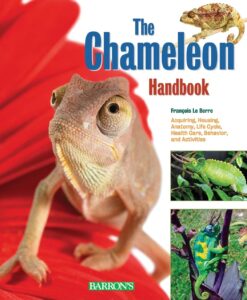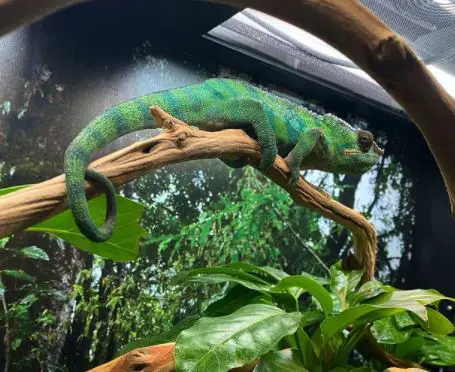What do chameleons eat
What do chameleons eat: Chameleons, with their captivating ability to change color and their unique physical adaptations, have long held a spellbinding allure for both scientists and reptile enthusiasts. These remarkable reptiles belong to the family Chamaeleonidae and are renowned for their extraordinary camouflage skills, which allow them to blend seamlessly into their surroundings. While chameleons may be admired for their striking appearance, it is crucial to delve deeper into their fascinating dietary needs to ensure their well-being in captivity or in the wild.
Brief Overview of Chameleons as Fascinating Reptiles
Chameleons are characterized by their distinctive physical features, including independently moving eyes that provide a panoramic view of the world around them. Their zygodactylous feet – with fused toes arranged in two opposing groups – enable them to perch securely on branches and traverse even the most delicate foliage with agility.
Additionally, chameleons possess prehensile tails that aid in maintaining balance while climbing. One of the most remarkable aspects of chameleon physiology is their ability to change coloration instantaneously.
These color changes are not only mesmerizing but also serve several functions such as communication, thermoregulation, camouflage for hunting or avoiding predators, and expressing emotions. Through the movement of specialized cells called chromatophores situated beneath the skin surface, chameleons can rapidly alter pigments within these cells to create various vibrant hues.
Importance of Understanding Their Dietary Needs
 To ensure the well-being and longevity of chameleons both in captivity and in the wild, it is imperative to comprehend their specific dietary requirements. Chameleons are primarily insectivores; however, certain species have been observed consuming vegetation as well. The nutritional components obtained through their diet play a crucial role in sustaining their overall health, growth, and reproductive capabilities.
To ensure the well-being and longevity of chameleons both in captivity and in the wild, it is imperative to comprehend their specific dietary requirements. Chameleons are primarily insectivores; however, certain species have been observed consuming vegetation as well. The nutritional components obtained through their diet play a crucial role in sustaining their overall health, growth, and reproductive capabilities.
By comprehending the dietary needs of chameleons, we can provide them with appropriate nourishment that promotes their optimal physical condition and longevity. Understanding the intricate relationship between nutrition and chameleon health helps prevent deficiencies, metabolic disorders, and other potential ailments that may arise from an inadequate or imbalanced diet.
Furthermore, accurate knowledge of chameleon dietary habits aids in creating suitable feeding strategies for those kept in captivity. Delving into the mesmerizing world of chameleons unveils a wealth of knowledge about these extraordinary reptiles’ unique characteristics.
Understanding their dietary requirements serves as a cornerstone for their well-being and growth, ensuring they thrive in both captive environments and natural habitats. By delving deeper into the intricacies of what constitutes a nutritious chameleon diet, we can provide these captivating creatures with the nourishment they need to flourish.
General Diet of Chameleons
Chameleons are renowned for their unique ability to change colors and blend seamlessly into their surroundings, but their dietary habits are equally fascinating. As ectothermic reptiles, chameleons rely on external sources to regulate their body temperature and provide the energy needed for survival. Their diet primarily consists of insects, making them insectivores by nature.
Insects as the primary food source
In the quest for sustenance, chameleons are equipped with remarkable hunting skills that allow them to snatch prey with precision and speed. The diverse array of insects that form their primary food source includes crickets, grasshoppers, flies, beetles, and moths. This broad range ensures a varied diet that provides essential nutrients for growth and overall health.
Variety of insects consumed
Crickets are particularly favored by chameleons due to their high protein content and ease of availability in captivity. They offer a good balance of nutrients such as amino acids, vitamins, and minerals essential for the reptile’s well-being.
Grasshoppers are also commonly consumed due to their relative size and ability to provide a hearty meal for larger chameleon species. Flies serve as a staple insect in the wild since they are abundant in most habitats where chameleons reside.
Nutritional benefits derived from insects’ high protein content
 Protein plays a vital role in a chameleon’s diet as it aids in muscle development and repair. Insects serve as an excellent source of protein due to their high composition of amino acids. Proteins derived from insect consumption contribute significantly to the growth and maintenance of bodily tissues in juvenile chameleons while supporting reproductive health in adults.
Protein plays a vital role in a chameleon’s diet as it aids in muscle development and repair. Insects serve as an excellent source of protein due to their high composition of amino acids. Proteins derived from insect consumption contribute significantly to the growth and maintenance of bodily tissues in juvenile chameleons while supporting reproductive health in adults.
Additionally, these small arthropods offer other essential nutrients like vitamins (A, B complex, and D) and minerals (calcium, phosphorus, and iron), which are crucial for various bodily functions. These elements promote strong bones and aid in proper metabolic functioning, ensuring a healthy chameleon.
The general diet of chameleons revolves around insects as their primary food source. The variety of insects consumed includes crickets, grasshoppers, flies, beetles, and moths.
The nutritional benefits derived from these insects’ high protein content are vital for muscle development and repair in chameleons while also providing essential vitamins and minerals necessary for overall health. Understanding the intricacies of a chameleon’s diet allows owners or enthusiasts to provide appropriate nutrition to ensure the well-being of these remarkable reptiles.
Unique Feeding Mechanisms of Chameleons
Tongue projection and accuracy in capturing prey
What do chameleons eat: Chameleons possess an extraordinary ability to capture prey with accuracy, thanks to their remarkable tongue projection mechanism. The chameleon’s tongue, which is attached to its mouth by a bone called the hyoid, can be rapidly projected outwards towards prey with incredible precision.
This remarkable adaptation allows them to catch insects from a distance, often deceiving their prey with lightning-fast strikes. It is estimated that some chameleon species can extend their tongues up to twice the length of their body.
Elaborate tongue structure with specialized muscles and sticky tip
What do chameleons eat: The intricate structure of a chameleon’s tongue plays a vital role in its feeding success. Composed of various layers, the tongue consists of specialized muscles, collagen fibers, and mucus-secreting glands. These components work together harmoniously to enable precise targeting and capture of prey.
The muscles responsible for launching the tongue are incredibly strong and are capable of generating rapid acceleration. What truly sets chameleon tongues apart is the presence of a unique adhesive mechanism at the tip.
Upon striking an insect, the tip flattens and forms a suction cup-like structure that adheres firmly to the prey. This sticky surface ensures that once captured, the insect remains securely trapped on the chameleon’s tongue until it is retracted back into its mouth.

Lightning-fast tongue extension to catch fast-moving insects
What do chameleons eat: To effectively hunt fast-moving insects such as flies or moths, chameleons have evolved lightning-fast reflexes for extending their tongues within milliseconds after spotting their target. This exceptional speed allows them to seize agile prey before it has time to react or escape.
Incredibly enough, research has shown that when capturing food using their tongues, chameleons rely on visual targeting. They use a combination of binocular vision and depth perception to accurately determine the distance, direction, and speed of their prey.
This ability is further enhanced by the unique arrangement of their eyes, which allows them to independently scan different areas of their surroundings simultaneously. Chameleons’ feeding mechanisms are nothing short of extraordinary.
Their elaborate tongue structure, specialized muscles, and lightning-fast reflexes enable them to precisely capture fast-moving prey with remarkable accuracy. This remarkable adaptation showcases nature’s ingenuity and highlights how these fascinating reptiles have evolved to thrive in their unique habitats.
Specialized Diets Among Different Chameleon Species
Vegetarian chameleons – exceptions to the insect-based diet norm
Subverting the conventional understanding of chameleons as exclusively insectivorous creatures, certain chameleon species have emerged as notable exceptions by adopting a predominantly vegetarian diet. These unique reptiles, such as Jackson’s chameleon (Trioceros jacksonii) and Meller’s chameleon (Trioceros melleri), exhibit remarkable adaptations that allow them to thrive on a plant-based menu. While their carnivorous counterparts rely on insects for their sustenance, these vegetarian chameleons have developed specialized mechanisms to extract vital nutrients from leaves, flowers, and fruits.
Jackson’s chameleon and Meller’s chameleon
Jackson’s and Meller’s chameleons exemplify the fascinating diversity within vegetative dietary habits among these reptiles. Native to the East African regions of Kenya and Tanzania, Jackson’s chameleon boasts a remarkable ability to consume various plant matter while supplementing its nutritional needs with occasional insect intake. This adaptability allows it to thrive in both forested areas where insects are abundant and arid regions with scarce prey availability.
Meller’s chameleon, on the other hand, is endemic to parts of East Africa such as Kenya, Tanzania, Uganda, and Malawi. It has evolved an even more specialized vegetarian diet compared to Jackson’s chameleon.
This species primarily feeds on leaves from trees like Acacia species along with flowers and fruits found within its natural habitat. Remarkably, Meller’s chameleons possess unique jaw structures that enable them to efficiently chew plant material for optimal digestion.
Consumption of leaves, flowers, and fruits for nutrition
 What do chameleons eat: Vegetarian chameleons possess distinct physiological features that facilitate their consumption of leaves, flowers, and fruits. Unlike their insectivorous counterparts that have specialized jaw muscles for capturing prey, these vegetarian species have developed broader skulls with adaptations suited for more efficient herbivory. Their teeth are designed to shear and slice plant matter effectively.
What do chameleons eat: Vegetarian chameleons possess distinct physiological features that facilitate their consumption of leaves, flowers, and fruits. Unlike their insectivorous counterparts that have specialized jaw muscles for capturing prey, these vegetarian species have developed broader skulls with adaptations suited for more efficient herbivory. Their teeth are designed to shear and slice plant matter effectively.
Moreover, the digestive systems of these chameleons have adapted to efficiently process plant material. They possess a longer digestive tract compared to their carnivorous counterparts, allowing for extended fermentation and extraction of nutrients from fibrous vegetation.
Additionally, vegetarian chameleons may exhibit unique gut microbiomes that aid in breaking down plant components like cellulose. While the majority of chameleon species are known for their insectivorous diets, exceptions exist in the form of vegetarian chameleons like Jackson’s and Meller’s chameleons.
These intriguing reptiles have adapted to consume leaves, flowers, and fruits as their primary sources of nutrition. Through specialized anatomical features and digestive adaptations, they demonstrate the incredible diversity within the dietary habits of these captivating creatures.
Rarely Known Dietary Habits of Chameleons
Cannibalistic tendencies in certain species
When faced with scarcity of food, some larger chameleon species have developed remarkable survival strategies, including cannibalism. While this behavior may seem shocking, it is primarily observed among certain chameleon species inhabiting challenging environments where resources are limited. Cannibalistic tendencies emerge as a means for these chameleons to ensure their own survival when prey items are scarce or difficult to find.
Intriguing adaptation to ensure survival in challenging environments
What do chameleons eat: The occurrence of cannibalism among larger chameleon species highlights their remarkable ability to adapt and thrive in the face of adversity. By preying on members of their own species, these chameleons display a unique adaptation that allows them to exploit available food resources efficiently. This behavior demonstrates their capacity for resilience and underscores the fascinating ways in which nature facilitates the survival of diverse species.
Nutritional Requirements for Healthy Chameleons
Calcium supplementation for proper bone development
To maintain healthy bone development, calcium supplementation is crucial for chameleons. These reptiles require a balanced calcium-to-phosphorus ratio in their diet since an inadequate calcium intake can lead to severe health issues such as metabolic bone disease. Adequate calcium levels promote strong skeletal structure and ensure proper muscle function, contributing to overall wellbeing.
Importance of calcium-to-phosphorus ratio in diet
Maintaining an appropriate calcium-to-phosphorus ratio is vital as it supports essential bodily functions such as nerve transmission, muscle contraction, and blood clotting. Chameleons rely on dietary sources rich in calcium while carefully managing phosphorus intake since high phosphorus levels can hinder effective absorption of calcium from the digestive system. Achieving a balanced ratio is essential to prevent adverse health effects and promote optimal growth and development.
Potential health issues resulting from calcium deficiency
A deficiency of calcium in a chameleon’s diet can have serious consequences. Without sufficient calcium, these reptiles may suffer from weakened bones, deformities, muscle spasms, metabolic disorders, and reduced immune function. It is crucial for chameleon owners to provide appropriate calcium supplementation or ensure that their pets have access to a varied diet with adequate calcium content to prevent these potential health issues.
What do chameleons eat: Factors Influencing Chameleon Feeding Behavior
Environmental conditions affecting appetite and feeding patterns
Chameleon feeding behavior is greatly influenced by environmental conditions. Temperature fluctuations play a significant role in regulating their metabolism and digestion processes. Lower temperatures may decrease their appetite and slow down digestion, while higher temperatures can increase hunger levels.
Additionally, light intensity impacts hunting behaviors as chameleons rely on visual cues to detect prey items. Dim lighting conditions might hinder their ability to hunt effectively.
Temperature fluctuations impacting metabolism and digestion
Chameleons are ectothermic creatures, meaning they rely on external heat sources to regulate their body temperature. Temperature fluctuations influence their metabolism, which directly affects energy expenditure and food consumption. Higher temperatures generally lead to an increased metabolic rate and enhanced digestive processes in these reptiles while colder temperatures can slow down physiological functions.
Light intensity influencing hunting
The availability of suitable prey items is closely linked to light intensity since chameleons actively hunt visually. Adequate illumination ensures better visibility for spotting insects or other small organisms that serve as their primary food source. Light intensity also affects the effectiveness of color-changing camouflage mechanisms employed by chameleons during hunting activities.
To sum up what do chameleons eat
Understanding the rarely known dietary habits of chameleons sheds light on their incredible adaptability and survival strategies. These reptiles have evolved fascinating cannibalistic tendencies to secure sustenance in challenging environments. Additionally, meeting the nutritional requirements of chameleons, particularly regarding calcium supplementation, is vital to ensure their overall health and well-being.
Environmental factors such as temperature fluctuations and light intensity significantly influence chameleon feeding behavior. By appreciating these complexities, we can better appreciate the remarkable creatures that chameleons are and how they navigate their natural habitats with finely tuned instincts.
Further Reading:
- Best Turtle Substrate For Your Pet Tank
- Coconut substrate for chameleons
- Caught my Chameleon eating moss


